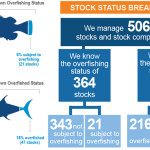At the beginning of 2023, economists predicted the U.S. was either in – or would soon be in – a recession, while the E.U. faced similar predictions of slowed growth and high inflation.
During the Global Seafood Market Conference in early 2023, Wells Fargo Senior Economist Tim Quinlan said a recession was “penciled in” for the U.S., as signs pointed to dropoffs in consumer sentiment and the highest inflation in 40 years. In late 2022, the European Commission published its economic forecast, stating the E.U. economy was at “a turning point” and predicting contracting economic activity in the first quarter of 2023, with most member states expected to “experience a technical recession” in the winter of late 2022 and early 2023.
Now, a year out, it’s clear that some of those predictions weren’t entirely accurate. By autumn, the E.U.’s economic forecast had shifted to “a modest recovery ahead,” and at the Global Seafood Market Conference in early 2024, economists were predicting falling inflation in the U.S. as consumer confidence continued to return.
Still, the World Bank’s latest report shows that the economic outlook is less than ideal. It found that global economic output will edge down in 2024, and the years spanning 2020 to 2024 saw the weakest start to global growth in a decade since the 1990s. The bank said growth in China and the U.S. is expected to slow, while Europe will see only slight growth due to lower inflation boosting real wages.
The World Bank report also said the E.U. will see persistently high inflation that is likely to prevent the easing of monetary policies in most economies, which will weigh on private consumption.
The overall economic outlook in 2024 is hard to predict, according to the World Bank, and could shift based on a number of factors – including unexpectedly stubborn inflation in advanced economies, weaker-than-projected growth in China, or the escalation of geopolitical conflicts like the wars in Ukraine and in the Middle East. The bank’s prediction could also be underestimating the pace of growth, as it said resilient economic activity and declining inflation in the U.S. could keep growth stronger than expected.
The World Bank’s predictions were punctuated soon after by Japan, the U.K., Ireland, and Finland announcing their economies weakened slightly in the last quarter of 2023 – the second straight quarter of contraction, which meets the technical definition of a recession.
The European Commission’s winter 2024 economic forecast, released on 15 February 2024, said that the E.U. entered 2024 on “weaker footing than expected.” The report predicts inflation will slow down, but growth in the E.U. and the Euro region was just 0.5 percent in 2024, barely avoiding a recession for the E.U. as a whole.
The commission’s report then added that growth is expected to regain traction after the weak start and that there was a faster-than-expected decline in inflation. However, it also said the report is extremely uncertain given the geopolitical tensions and the potential for supply bottlenecks – citing many of the same reasons as the World Bank.
“The European economy has left behind it an extremely challenging year, in which a confluence of factors severely tested our resilience,” European Commissioner for the Economy Paolo Gentiloni said in a release. “The rebound expected in 2024 is set to be more modest than projected three months ago but to gradually pick up pace on the back of slower price rises, growing real wages, and a remarkably strong labor market.”
For the seafood industry, the impacts of inflation and economic issues were just as varied and hard to predict as for overall economies.
In the U.S., inflation drove consumers toward value-focused channels in 2023. Metrics from consumer data firm Circana showed 55 percent of seafood shoppers looked for sales and deals more often throughout 2023 in a number of different ways – including clipping coupons, following in-store promotions, or seeking less expensive private-label products.
Compared to pre-pandemic times, shopping habits shifted in the U.S. In 2019, traditional grocery stores accounted for 39.9 percent of refrigerated seafood sales, but in 2023, that number had dropped to 36.8 percent. Refrigerated seafood sales at “club stores” – which are often cheaper – rose from 19.5 percent pre-pandemic to 21.2 percent in 2023, and discount grocery store sales increased from 6.3 percent to 7.1 percent, per Circana’s data.
Those shifts in 2023 first laid their roots in 2022, when food and beverage inflation spiked dramatically. According to Circana, prices jumped 12.5 percent in 2022, and then consumers faced 11.4 percent inflation in Q1 2023. That inflation continued before finally starting to slow in the latter half of 2023, with seafood inflation dropping even faster than other food categories.
A report by 210 Analytics President Anne-Marie Roerink said that in the U.S., seafood will have to overcome the cost gap between it and other proteins going into 2024.
“The market typically experiences a delay in consumer demand ticking back up once prices come down,” she said. “Given the duration and depth of inflation and the higher cost of seafood in comparison to some of the meat and poultry proteins, that delay may be longer than normal.
The inflation story was slightly different in the E.U., according to a study by the European Market Observatory for Fisheries and Aquaculture Products (EUMOFA). That study, “The E.U. Fish Market – 2023 edition,” found that in 2022, E.U. household expenditures on seafood products increased 11 percent compared to 2021, with the bloc’s imports increasing 23 percent by value year over year to EUR 31.9 billion (USD 34.9 billion). However, much of that growth was related to higher prices as import volumes decreased 3 percent to 6.1 million metric tons (MT) – below pre-pandemic levels.
The overall picture for European seafood consumption, meanwhile, is slightly pessimistic. The E.U. Fish Processors and Traders Association’s (AIPCE-CEP) latest finfish study, published in September 2023, found that per-capita seafood consumption hit 22.1 kilograms in 2022, marking a drop from the 22.4 kilograms consumed in 2021 and a continuation of a multi-year trend of declining seafood consumption.
Exports, as well, declined in volume but increased in price. The value of the E.U.’s exports in 2022 reached EUR 8.1 billion (USD 8.7 billion), but the volume decreased by 5 percent to 2.3 million MT. As the value of imports increased faster than the value of exports, that put the E.U.’s seafood trade deficit at 25 percent, or EUR 4.73 billion (USD 5.11 billion) higher in 2022 than in 2021.
Still, forecasts for many corners of the seafood industry remain more positive going into 2024 than they were in 2023. Rabobank, a multinational banking and financial services company, found through surveys that the global aquaculture industry was more optimistic at the start of 2024. Most companies and individuals surveyed predicted growth across major aquaculture species like shrimp, salmon, and tilapia.
Market prices, though, are still at the top of the industry’s concerns.
“There remain uncertainties about the effects of persistent inflation and the recovery of seafood demand,” the Rabobank report said. “Elevated costs and stagnating household disposable incomes remain challenges for consumers across major markets. Consumers may look to trade down, either within the seafood category or to lower-priced protein options.”
Looking even further forward, the World Bank is predicting Europe will see stronger growth in 2025 at 2.7 percent, supported by strengthening domestic demand and a gradual recovery. It added that if the economic status of Russia and Ukraine are excluded, growth is predicted to accelerate to 3.1 percent in 2024 and 3.7 percent in 2025.








